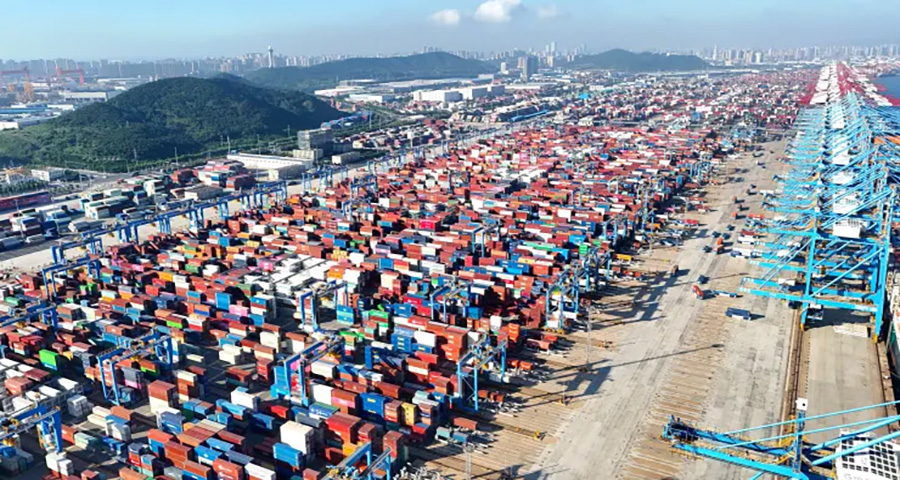U.S. Tariff Plans Bring Urgency to Knowing Product Manufacturing Locations
KEY POINTS
- The Trump administration promises sharp tariff increases in early 2025
- 10-20% universal tariffs plus country-specific tariffs on China, Mexico, and Canada
- Healthcare organizations tailor SRS to understand their exposure

Tariffs and port disruptions in 2025 underscore the urgent need for supply chain transparency and a focus on local sourcing strategies.
Healthcare Sourcing executives will face sharp increases in product costs in early 2025 if the Trump administration makes good on promises of swift action on universal and country-specific import tariffs. The incoming Trump administration is proposing a 10-20% tariff on all imports, as well as country-specific tariffs on the U.S.’ top three trading partners: China (additional 10%), Mexico (25%), and Canada (25%). Trump stated the tariffs on Mexico and Canada would be imposed until the countries take stronger action to curb the flow of drugs, particularly fentanyl, and migrants crossing the border. However, such unilateral tariffs would violate the United States-Mexico-Canada Agreement (USMCA) on free-trade.
Meanwhile, the Biden administration’s Section 301 tariffs on syringes, needles, respirators, gloves, and facemasks phase in tariffs of 25% to 100% in three phases starting September 27, 2024, January 1, 2025, and January 1, 2026.
Healthcare Sourcing teams are using SRS to examine manufacturing locations of key products to understand tariff exposure. Healthcare suppliers use SRS to categorize the medical devices, laboratory products, and pharmaceuticals made at each of their sites that supply to North American healthcare providers.
Tariffs increase the urgency of knowing where the products you buy are manufactured. You can find out by tailoring SRS to your suppliers and the products you buy from them. That way, you can gauge your exposure by running reports such as Product Sites and Risks; Products Subject to China Tariffs; and Supplier Geopolitical Summary. Besides tariff and geopolitical impact analysis, another benefit is that SRS alerts will attach your products impacted by disasters and other supply chain incidents.
Healthcare Sourcing executives have experienced many import disruptions over recent years, prompting them to value supply chain transparency and to rethink reliance on global supply networks. Tariff costs add another benefit to the long-term trend towards increasing Sourcing content from U.S. manufacturers in response to volatile global supply chain and logistics threats. Sourcing from manufacturers closer to home reduces cost and delivery risks associated with exposure to port and logistics strikes, geopolitical regulations, conflict, and tariffs.
The potential for swift, sharp cost increases due to tariffs adds urgency to evaluate product import exposure. The second half of January 2025 may also see a disruption of product imports through East and Gulf Coast ports, also available through SRS. If you have not yet tailored SRS to your suppliers and the products you buy, the time to do so is now. Email support@supplyrisk.com for instructions.
For more information, see:
Reuters, Trump vows new Canada, Mexico, China tariffs that threaten global trade, November 26
Reuters, Trump tariff vow hits Mexican and Canadian currencies, yen firm, November 26, 2024
The Guardian, China, Canada and Mexico hit back at Trump’s tariff plan amid warnings of impact on US economy – live, November 26, 2024
Supply Chain Dive, Back to (North) America: Companies Reassess Their Supply Chain Strategies, November 26
The New York Times, Trump Transition Live Updates: Mexico Prepared to Retaliate With Tariffs of Its Own, Leader Says, November 26
Supply Risk Solutions, ILA-USMX Port Negotiations Stall as Deadline Looms, November 19
Supply Risk Solutions, Tariffs Push Manufacturers to Rethink Supply Chain Strategies, November 15
Supply Risk Solutions, Tariffs Spur Urgency to Understand Product Manufacturing Locations, November 11
Center for Strategic & International Studies, Making Tariffs Great Again: Does President Trump Have Legal Authority to Implement New Tariffs on U.S. Trading Partners and China?, October 10